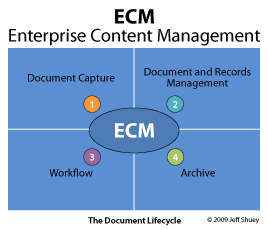The introduction of ECM-solutions: what to talk with the client
 From the translator . We know from our own experience that well-built customer interaction is key to the successful implementation of ECM systems. How to adequately assess the state of affairs in the organization of the client? How to identify existing problems and identify ways to solve them? What moments in communicating with the client should pay attention in the first place? There are practically no publications on the organization of work on the implementation of ECM solutions on the Russian-language Internet. We offer to our readers the translation material in which these issues are raised.
From the translator . We know from our own experience that well-built customer interaction is key to the successful implementation of ECM systems. How to adequately assess the state of affairs in the organization of the client? How to identify existing problems and identify ways to solve them? What moments in communicating with the client should pay attention in the first place? There are practically no publications on the organization of work on the implementation of ECM solutions on the Russian-language Internet. We offer to our readers the translation material in which these issues are raised.A huge part of their time, an expert in the implementation of ECM-solutions spends in communication with customers. As a result, the conversation should form a clear idea of the current state of affairs of the client, the result to be obtained after the implementation of the decision, as well as what steps should be taken to achieve this result.
In dealing with a client, various topics may be covered, but one way or another, attention should be focused on the following points:
1. Key goals and priorities of the business : what are the main goals and objectives pursued by the organization?
2. Processes and types of documents : what are the main business processes of an organization? What types of documents are needed to support these processes? What sources of information do you most often have to deal with? What is the level of complexity of these processes (the number of documents, employees, the need to harmonize documents, etc.)?
3. Volumes of documents : what is the total volume of documents used in the work? How will this volume change in the near future: will it increase or decrease?
4. Work style : how exactly work with documents is carried out: each employee conducts work on his documents alone, documents go through a chain of approvals or do documents are created and edited in collaboration?
5. Creating documents : how are documents created in an organization? How many employees are involved in the process of creating documents? How are changes tracked in documents? Are there (and if so, which problems exist) problems with version control of documents?
6. Reviewing and approving documents : How is reviewing and approving documents most often identified? How many people are involved in this process? What are their roles?
7. Tools : what tools are used to create, authorize and approve documents? Are all these processes automated at the moment? If so, by what means?
8. Distribution of documents : how is the reproduction and distribution of documents: by printing on paper, posting on the corporate website or sending by e-mail? Which of the employees of the organization need to provide access to documents? Do I need to provide access to documents to users who are not employees of the organization?
9. Archiving of documents : Do you need to save documents in the archive after they have been created and used in the work? What are the requirements in the organization for archiving documents? What is the period of archival storage of documents? What policies and procedures apply to archival documents? Are they respected by the employees of the organization?
10. Main problems : what problems and difficulties do you most often encounter when working with documents?
11. Perfect condition : what changes would the client like to see in the work of the organization? What would you like to change in your current job?
')
It is these eleven moments that must somehow be touched. Small note: this list is compiled for organizations whose main activity is to work with information. For production companies such a list will be different: first of all, it is necessary to clarify items 5 and 6 in order to get a more detailed picture of the customer’s business processes, as well as the specifics of the documents used and work with them.
Source: https://habr.com/ru/post/136310/
All Articles